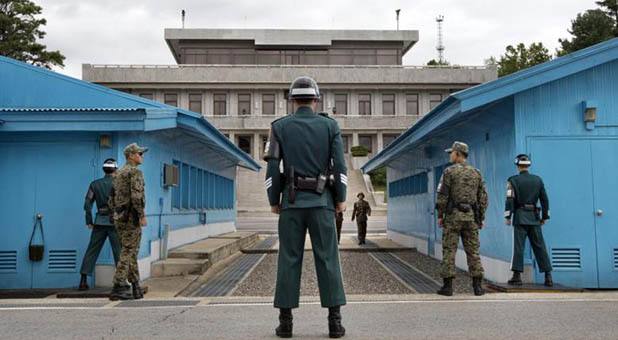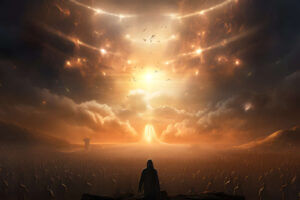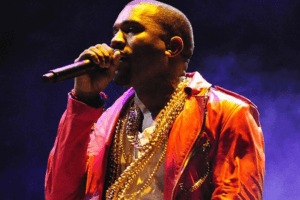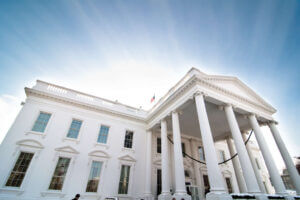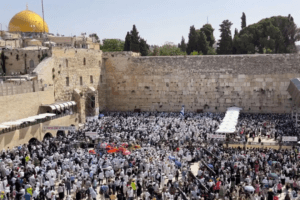This past summer I was invited to teach literary interpretation and academic writing at a small Reformed-Christian seminary outside of Seoul, South Korea. At the close of two intense weeks of instruction, which consisted of six hours of lectures and discussion each day, I was ready to decompress. My hosts recommended that I visit the Demilitarized Zone (DMZ), a most ironic name due to the heavy presence of military personnel and equipment along the contested border. I fondly remember watching episodes of the sardonic TV series M*A*S*H with my family as a child, and I was keen to visit this historic site. Due to North Korea’s recent ICBM saber rattling and tyrannical imprisonment, even murder, of American visitors to that dark land of communist oppression, I was understandably nervous about even traveling to South Korea for this teaching gig, let alone venturing to within four kilometers (2.5 miles) of the very heart of darkness. Trusting that my South Korean hosts would not knowingly imperil my life, I agreed to the tour.
Boarding a large, modern tour bus with comfortable seats, air conditioning and on-board television, the sad irony was inescapable: For a small fee of only $55, which amounts to approximately $30 less than the average North Korean monthly salary, I enjoyed an entertaining and educational diversion, complete with amenities, food and refreshments, the type of experience that a vast majority of North Koreans will never know. Tragic. I remind my students that ideas have consequences, and the persistent tyranny of communism in the name of “the people” in North Korea and elsewhere serves as just one of many examples.
As we approached the DMZ, concrete barricades and barbed-wire fences along the highways and bridges disturbed the pastoral vistas of rice-paddy farms along the base of beautiful hills and mountains. We soon approached the civilian checkpoint, and two young, stern South Korean soldiers boarded the bus, checking each person’s passport. We were instructed to remove hats and glasses, and we were warned to put our cell phones away and to not take any pictures. There was the requisite knucklehead (every tour has one) who kept snapping pictures until the very last possible moment, frantically stuffing his phone into his backpack as a helmeted soldier entered the bus.
Both soldiers looked so young. Because they were. Men in South Korea are required to serve two years in the military. They generally start college at the age of 19, finish one year of education, and then serve two years in the military before returning to college. Apparently, it is easier to get into college right out of high school, so most Korean men apply to college first before starting their military service. The mandatory military service reminded me of South Korea’s precarious national security. North Korea remains a true existential threat, because, technically, North and South Korea are still at war. This reality is most intensely felt in a zone that is supposed to be demilitarized.
Our first touring stop was Dora Observatory, built by the South Korean Ministry of Defense in 1986. The observatory is the nearest point to North Korea one can visit on the South Korean side, and from this vantage point, one can see the two villages that remain in the DMZ. Daesong-dong is on the South Korean side, and Kijong-dong is on the North Korean side. Both villages pre-date the DMZ, and they were allowed to remain once the DMZ was established after the 1953 cease-fire agreement. The people living in Daesong-dong are considered South Korean citizens, and they can vote in South Korean elections, but they are not required to pay taxes or serve in the military.
Kijong-dong, also known as Peace Village, is actually a propaganda village. True to form, the North Korean government claims it is a collective farming village, but the buildings do not have glass windows, there does not appear to be any interior rooms, and building lights turn off and on at regularly scheduled times. The day I visited the observatory was rainy and cloudy, so I could not see the villages clearly. However, I could see the huge flagpoles resulting from a competition during the 1980s. Daesong-dong built a flagpole roughly 98 meters high (323 feet) and displayed an enormous South Korean flag. Not to be outdone, the North Korean government erected a flagpole 160 meters tall (525 feet) and displayed an even larger North Korean flag. I could not help but wonder how many North Korean families could have been fed with the money wasted on this meaningless display of flag superiority.
The most unnerving aspect of the Dora Observatory were the loudspeaker broadcasts. For decades, the North Korean government has broadcast propaganda news, invitations for South Koreans to “liberate” themselves and to defect to the north to live in “freedom” with their comrades in the fight against “capitalist oppression,” and patriotic opera, reminiscent of that produced in China during the Cultural Revolution. In response, the South Korean government broadcasts contemporary news, information about world events and K-pop dance music. There was a short reprieve of the broadcasts during the 1990s and early 2000s while economic exchange blossomed between the two countries. However, when the South Koreans realized that their good intentions at trade and helping the North Korean people with good paying industry jobs were being used by the North Korean military to develop its nuclear weapons program, South Korea stopped the trade, cancelled the manufacturing jobs and started broadcasting again. It is hard to explain, but hearing the high-volume broadcasts was chilling, as I was reminded of propaganda brainwashing characteristic of communist regimes around the globe. The classic strategies of the cold war are alive and well at the DMZ.
From Dora Observatory, we travelled to the site of Tunnel 3. Throughout the 1970s, North Korea dug a series of tunnels underneath the DMZ. To date, four such tunnels have been found and sealed. The North Korean military planned to dig tunnels underneath and across the DMZ, toward Seoul, with the purpose of providing soldiers and small artillery direct access for a surprise attack to conquer South Korea. These tunnels are a direct violation of the 1953 armistice. During the presentation explaining the North Korean plans and intentions, one young college student mumbled “alleged” just audibly enough to be annoying, as if there really were any doubt about who dug these tunnels and for what purpose. The tunnels decline to the north, allowing for debris and water to be removed and for digging to continue in a southerly direction. Moreover, North Korea admitted to creating the tunnels, claiming they were simply digging for coal. Curiously, they just so happened to be digging for coal underneath and across the DMZ, heading toward South Korea, in the direction of Seoul, in areas where there is no coal. To substantiate their claim, they conveniently spread charcoal on the floor of the tunnels and powdered the walls with charcoal dust. How convincing. There is no doubt: Ever since the 1953 armistice, North Korea has been planning its invasion and destruction of the southern territories, with near complete impunity. Should we believe their aspirations are any different today?
The incomplete Tunnel 3 is approximately one mile long (1,635 meters), 435 meters of which extend across the DMZ into South Korean territory, and is 73 meters (240 feet) below ground. As I walked through the tunnel, hunched over for most of the 300-plus meters that are open for visitors, I was both impressed and horrified by the tenacity and determination of the North Korean efforts to invade and destroy their southern neighbors. No, not neighbors, enemies, in their mind. The sheer audacity of digging these tunnels 70 meters below the surface, intending to stretch for kilometers and kilometers toward Seoul, overwhelmed my imagination. The determination was, I have to admit, admirable, but these efforts were marred by desperation. Who would do such a thing?
Back in Seoul at the conclusion of the tour, I pondered two thoughts over a tasty meal of spicy pork, rice and kimchi. First, the younger generations in South Korea no longer care about reunification with the north, for two main reasons. These younger South Koreans were born into a world in which there was already a division between the countries. For them, there has always been North and South Korea. They do not deeply feel the hurt of national division, and they do not miss family members trapped in the north as do their elders. Also, they do not wish to pay the higher taxes that would be required for reunification. They would have to pay for the political and economic process of reunification, and they do not want that bill. I can certainly understand such a concern, but must we reduce this humanitarian crisis to a matter of mere money? In the short term, the financial cost may be high, but in the longer term, wouldn’t the spiritual and material blessing of human flourishing for both the North and the South be worth the short-term cost?
The second thought I pondered over lunch cheered me up. I chuckled at the great irony of history and the good humor of providence. Despite all the harm intended by the North Korean regime in first attacking South Korea in 1950, aligning with the Soviet Union and China to push back the defensive advances of the South, and digging tunnels under the DMZ to stage a surprise attack on Seoul, the outcome has been a financial boon for South Korea. These failed attempts to colonize the capitalist South in the name of communism have led to increased commercialization and profit along the southern portion of the DMZ. Millions of U.S. dollars (billions of Korean won) are generated each year by tours just like the one I enjoyed, including all the souvenirs, snacks, food and drink sold in the tourist shops and cafes.
The dream of reunification may be fading for many in South Korea, but capitalism is thriving. The South Koreans have pulled themselves out of severe poverty since the 1950s by building a world-class powerhouse of an economy. Though the disastrous Korean War may have ended in a military stalemate, the South has clearly and undeniably won the economic war. My prayer is that the people of North Korea will one day be freed from the horrific tyranny of communism, taste the joys and challenges of freedom and enjoy the prosperity that necessarily ensues when the people are free to pursue happiness as they see fit.
Dr. David S. Hogsette is professor of English at Grove City College, where he serves as writing program director.
This article was originally published at VisionAndValues.org. Used with permission.
See an error in this article?
To contact us or to submit an article


